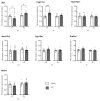Impact of Chronic Multi-Generational Exposure to an Environmentally Relevant Atrazine Concentration on Testicular Development and Function in Mice
- PMID: 36831314
- PMCID: PMC9954248
- DOI: 10.3390/cells12040648
Impact of Chronic Multi-Generational Exposure to an Environmentally Relevant Atrazine Concentration on Testicular Development and Function in Mice
Abstract
A common herbicide, atrazine, is associated with poor health. Atrazine acts as an endocrine disruptor at supra-environmental levels. Little research, however, has been conducted regarding chronic exposure to environmental atrazine concentrations across generations. This study utilized comprehensive endpoint measures to investigate the effects of chronic exposure to a conservative atrazine concentration (0.02 ng/mL), measured in Australian waterways, on male mice fertility across two generations. Mice were exposed through the maternal line, from the pre-conception period and through the F1 and F2 generations until three or six months of age. Atrazine did not impact sperm function, testicular morphology nor germ cell parameters but did alter the expression of steroidogenic genes in the F1, down-regulating the expression of Cyp17a1 (Cytochrome P450 family 17, subfamily A member 1; p = 0.0008) and Ddx4 (DEAD-box helicase 4; p = 0.007), and up-regulating the expression of Star (Steroidogenic acute regulatory protein; p = 0.017). In the F2, atrazine induced up-regulation in the expression of Star (p = 0.016). The current study demonstrates that chronic exposure to an environmentally relevant atrazine concentration perturbs testicular steroid-associated gene expression that varies across generations. Future studies through the paternal and combined parental lineages should be undertaken to further elucidate the multigenerational effects of atrazine on male fertility.
Keywords: atrazine; endocrine disruptor; multi-generational; testis.
Conflict of interest statement
The authors declare no conflict of interest.
Figures





Similar articles
-
Chronic Atrazine Exposure Beginning Prenatally Impacts Liver Function and Sperm Concentration With Multi-Generational Consequences in Mice.Front Endocrinol (Lausanne). 2020 Nov 26;11:580124. doi: 10.3389/fendo.2020.580124. eCollection 2020. Front Endocrinol (Lausanne). 2020. PMID: 33324343 Free PMC article.
-
Changes in testicular morphology and steroidogenesis in adult rats exposed to Atrazine.Reprod Toxicol. 2010 Jun;29(3):323-31. doi: 10.1016/j.reprotox.2009.12.006. Epub 2010 Jan 4. Reprod Toxicol. 2010. PMID: 20045047
-
Multigenerational and transgenerational impact of paternal bisphenol A exposure on male fertility in a mouse model.Hum Reprod. 2020 Aug 1;35(8):1740-1752. doi: 10.1093/humrep/deaa139. Hum Reprod. 2020. PMID: 32644108
-
DNA methylation 6 mA and histone methylation involved in multi-/trans-generational reproductive effects in Caenorhabditis elegans induced by Atrazine.Ecotoxicol Environ Saf. 2023 Jan 1;249:114348. doi: 10.1016/j.ecoenv.2022.114348. Epub 2022 Dec 9. Ecotoxicol Environ Saf. 2023. PMID: 36508798
-
Atrazine exposure caused oxidative stress in male rats and inhibited brain-pituitary-testicular functions.J Biochem Mol Toxicol. 2024 Jan;38(1):e23579. doi: 10.1002/jbt.23579. Epub 2023 Nov 5. J Biochem Mol Toxicol. 2024. PMID: 37926918
Cited by
-
Resveratrol ameliorates atrazine-induced caspase-dependent apoptosis and fibrosis in the testis of adult albino rats.Sci Rep. 2024 Jul 31;14(1):17743. doi: 10.1038/s41598-024-67636-z. Sci Rep. 2024. PMID: 39085279 Free PMC article.
-
Beyond Genes: Mechanistic and Epidemiological Insights into Paternal Environmental Influence on Offspring Health.Curr Environ Health Rep. 2025 Aug 9;12(1):29. doi: 10.1007/s40572-025-00488-5. Curr Environ Health Rep. 2025. PMID: 40782138 Review.
-
tsRNA-00764 Regulates Estrogen and Progesterone Synthesis and Lipid Deposition by Targeting PPAR-γ in Duck Granulosa Cells.Int J Mol Sci. 2024 Oct 19;25(20):11251. doi: 10.3390/ijms252011251. Int J Mol Sci. 2024. PMID: 39457032 Free PMC article.
-
Atrazine Toxicity: The Possible Role of Natural Products for Effective Treatment.Plants (Basel). 2023 Jun 12;12(12):2278. doi: 10.3390/plants12122278. Plants (Basel). 2023. PMID: 37375903 Free PMC article. Review.
-
Ancestral lineages of dietary exposure to an endocrine disrupting chemical drive distinct forms of transgenerational subfertility in an insect model.Sci Rep. 2024 Aug 5;14(1):18153. doi: 10.1038/s41598-024-67921-x. Sci Rep. 2024. PMID: 39103404 Free PMC article.
References
-
- United Nations Environmental Programme & World Health Organization . In: State of the Science of Endocrine Disrupting Chemicals- 2012. Bergman A., Heindel J.J., Jobling S., Kidd K.A., Zoeller R.A., editors. United Nations Environmental Programme & World Health Organization; Geneva, Switzerland: 2013. pp. 1–289.
-
- Radcliffe J.C. Pesticide Use in Australia: A Review Undertaken by the Australian Academy of Technological Sciences and Engineering. Australian Academy of Technological Sciences and Engineering; Melbourne, Australia: 2002. pp. 1–319.
-
- Wang M. Visualizing pesticide usage in the United States from 1992 to 2009. Environ. Plan. A. 2016;48:455–457. doi: 10.1177/0308518X15604760. - DOI
-
- Australian Pesticides and Veterinary Medicines Authority . Atrazine Final Review Report and Regulatory Decision. Australian Government; Canberra, Australia: 2004. pp. 1–47.
Publication types
MeSH terms
Substances
LinkOut - more resources
Full Text Sources
Miscellaneous

